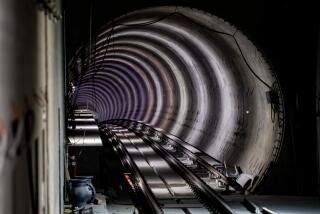Investors may not back bullet train until after it’s running, agency says
Investors may not be willing to back the state’s bullet train project until after it begins operating, the California High-Speed Rail Authority said in a letter to key legislators, an acknowledgment that again raises serious questions about how the $43-billion construction cost will be paid over the next decade.
The letter gives a preview of the authority’s upcoming business plan, a critical document that is supposed to address long-standing concerns that it lacks a credible blueprint for building and operating the system. Even supporters of the Southern California-to-San Francisco system have said the previous business plans were unrealistic in their estimates of construction costs and ridership numbers, among other things.
The business plan is expected to be filed Nov. 1; it and a related funding plan must be approved by the Legislature before the state can issue any of the $9 billion voters approved for the project in a 2008 bond measure. The Legislature has a 60-day window to approve the plans and then begin committing the state to bonds that would take several decades to pay off.
The authority wants to begin building an initial segment of the system from south of Chowchilla to north of Bakersfield, taking the trains through the Central Valley agriculture belt. That segment would cost about $6 billion, exactly what the authority would have in hand from past federal grants and matching bond funds.
Under the terms of federal grants that are providing about $3 billion in funding, the money has to be spent by 2017, putting the state on a tight schedule to approve the plan, obtain permits and build the initial segment.
Originally, the authority hoped to build the system based on three sources of funding: federal, state and private money. The letter by the authority, sent Friday, said for the first time that private investors are unlikely to put up cash before the system is operating.
Although it is not impossible to find some private money, the letter said “the authority is planning for a more likely market scenario in which private capital is attracted based on the revenues of the project once revenues are proven.” The failure to attract private investors earlier is seen by many critics as evidence that the state’s plan is excessively risky.
With private investors out of the picture and Congress now balking at providing any more than the existing funding, the upcoming business plan has to answer how it could hope to complete the project. One option appears to be a financing tool, being considered in a U.S. Senate subcommittee, in which the federal government would provide tax credits to holders of bonds used to help build the system, according to the authority’s letter to the Legislature’s budget committees.
Even if the Senate legislation were enacted, however, it would establish only a $50-billion program for all 50 states, leaving critics wondering about how realistic the authority is being in trying to raise the money. The authority could potentially seek to use the tax credit bonds to leverage its own bonds, securing more than three times the existing $9 billion through a financial engineering structure that would link the bond programs, according to the letter.
The financing tool, known as qualified tax credit bonds, would grant tax credits to the owners of the bonds in partial or full substitution for interest payments. That resulting loss of federal revenue flies in the face of the battle to reduce spending, a key reason that House Republicans have vowed to freeze expenditures on the rail project.
“The entire plan is wishful thinking,” said Elizabeth Alexis, a co-founder of Californians Advocating Responsible Rail Development, a Bay Area group that has been critical of the authority’s planning. “If it is a real possibility that the authority is not going to get more federal money in the future, then is there something different it should be doing with the money we do have? They don’t answer that question.”
But the state may be in a tough spot. Gov. Jerry Brown, who must give his own blessing to issue the bonds, is under pressure from the Obama administration to carry forward the existing plan to build a system that would send trains at up to 220 mph from Southern California to the Bay Area. Whether the Federal Railroad Administration would give Brown flexibility to change the plan or the route may be doubtful, political experts say.
More to Read
Sign up for Essential California
The most important California stories and recommendations in your inbox every morning.
You may occasionally receive promotional content from the Los Angeles Times.











